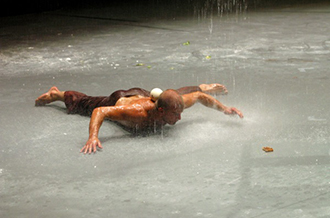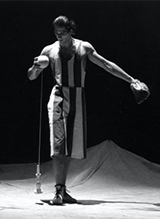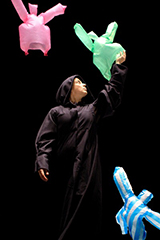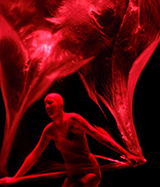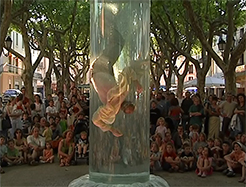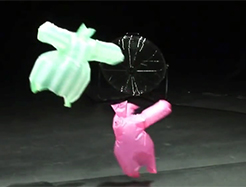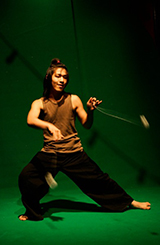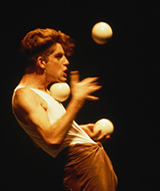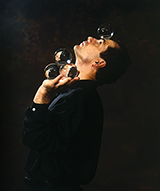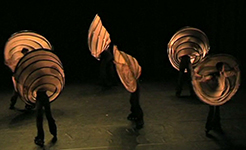by Jean-Michel Guy
Ironically, the notion of object manipulation, recent and now common, has arisen from the need to separate the notion of juggling, which has become dominant and too catch-all, even though in the middle of the 19th century juggling was still only a tiny part... of object manipulation. Obviously these two subsets of juggling share many characteristics such as certain techniques and the general notion of "suspension point" or "neutral position" and they can be combined. Yet most object manipulators call themselves as such rather than jugglers, especially when they handle only one object such as a sword, a Yo-Yo or a boomerang.
The age of deconstruction
The evolution of object manipulation and juggling are largely interdependent. Thus, three notions, deconstruction, modernisation and plasticity, characterise them in the same way. But each of these notions is expressed differently according to the types of juggling.
Deconstruction consists in questioning what we took for granted and dissociating from properties that we previously thought were inseparable. Since the 1990s, it has logically focused on the two notions of manipulation and object. The most radical deconstruction, which can serve as a grid analysis for all partial deconstructions, was theorised by the juggler Phia Ménard under the name of unjugglability and made manifest in her work Vortex. Caught in whirlwinds, by definition invisible, plastic shapes like sachets "dance" like magic according to choreographies that are both whimsical and very tight. Neither juggler nor any familiar juggling pattern appears in the ring. And besides, the public doubts that it is still juggling. And yet, it is very much juggling at the highest level, not so much that the work is signed by a juggler known for her classical juggling, but because it is part of a tradition of expert manipulation, while pushing its limits. What is manipulated is not a material, visible, tangible, audible object but a stream of air! Or rather a set of twenty streams of air, projected onto the ring by fans and whose orientation, power, active number are "manipulated", including according to classical juggling techniques, from an organ set, which is activated certainly by fingers, but above all by the artist's creative genius. The object is the wind. The manipulation is hands-free!
It's the object that manipulates me
Why "unjugglability"? Because juggling has no essence, no stable definition possible, it is simply becoming. It essentially occurs, says Phia Ménard, when an artist wonders whether or not an object is juggleable, finds the conditions for the possibility of juggling, and meets them. Consequently, any object is potentially "juggleable", in other words, susceptible to unprecedented manipulation. As for the manipulation itself, it is not a matter of standard gestures, but of invention. Juggler/object manipulator Jörg Muller puts it this way: "Every object has a certain form of desire for movement".
Phia Ménard and Jörg Muller are merely conceptualising a principle that is now obvious to all jugglers, and which is trivially expressed as follows: it is the object that manipulates me.
In reality, this principle is complicated by its extension, the manipulation of the public, in other words the dramaturgy. Who manipulates what and who? It must be said that object manipulation now extends to these confines, and that what is now "manipulated" with such bizarre instruments as the wind, are in fact reactions and feelings of admiration, strangeness, acknowledgement and meaning. The object of the manipulation is no longer a thing but a relationship.
And as far as things are concerned, the recent period is characterised by the fact that the object is surpassed by its material: egg yolks, mud, water, ice are all being manipulated. Oh, certainly, the long tradition of juggling with everything and anything is not interrupted: we manipulate porcelain diabolos, ceramic balls, Rubiks cubes, like dolls, rugs, books or funnels in the past. We also manipulate pixels. From this narrow point of view, we can say that object manipulation has a very bright future, just as long as our consumer society creates new objects.
The technological and artistic renewal
Another striking phenomenon is modernisation, not to be confused with what was said previously, even if they may overlap. The novelty is often technological. The classic juggling objects (balls, clubs, diabolos, rings...) are revisited, redesigned and improved as a market, or a community of amateurs, is formed. Within a classic system, technical innovation introduces new ways of juggling, just as the appearance of the Bourjois paint tube, easy to transport, allowed Van Gogh to leave his studio to paint outdoors... Here we must mention Michael Moschen's revolutionary major work, Triangle, which could not exist without the technological invention of the silicone ball.
Michael Moschen's revolutionary work is not only revolutionary because of this technical innovation: it is a departure from just about everything that could be called juggling before him. And that is why we can only talk about the evolution of object manipulation from an artist's position in relation to objects. He invented contact juggling, which despite its name in French is not juggling but a singular form of object manipulation. He invented unusual objects – and the juggling principles associated with them – and paved the way for graphic manipulation. He also made a profound contribution to the deconstruction process, asking philosophical and cultural questions that no one had previously imagined: how various civilisations perceive the void or allow to let go.
As an admirer of Moschen, Jérôme Thomas, who knew the French context and how to push it, would activate the missing keys to accomplish in Europe the revolution born in America: to have juggling recognised as an art, to have it produce long-lasting works, to involve it in a permanent creative process. Is it juggling or object manipulation when Jérôme Thomas comes up with the invention of a balancing ball on his wrist, which miraculously remains immovably there, while the juggler keeps circling around it? Technology inspires juggling: balls can now be manipulated by remote control. Tomorrow, – who knows? – a juggler in Singapore will catch, in the moment, an object thrown in Paris…
Furthermore, object manipulation, more plastic than ever, can now easily be combined with all other forms of manipulation: puppets, magic, musical instruments, and more generally all the arts, theatre, dance, video…
Thanks to this plasticity and the ongoing digital revolution, the various standard forms of object manipulation, such as ballistic, contact, graphical and skill are all undergoing a transformation.




